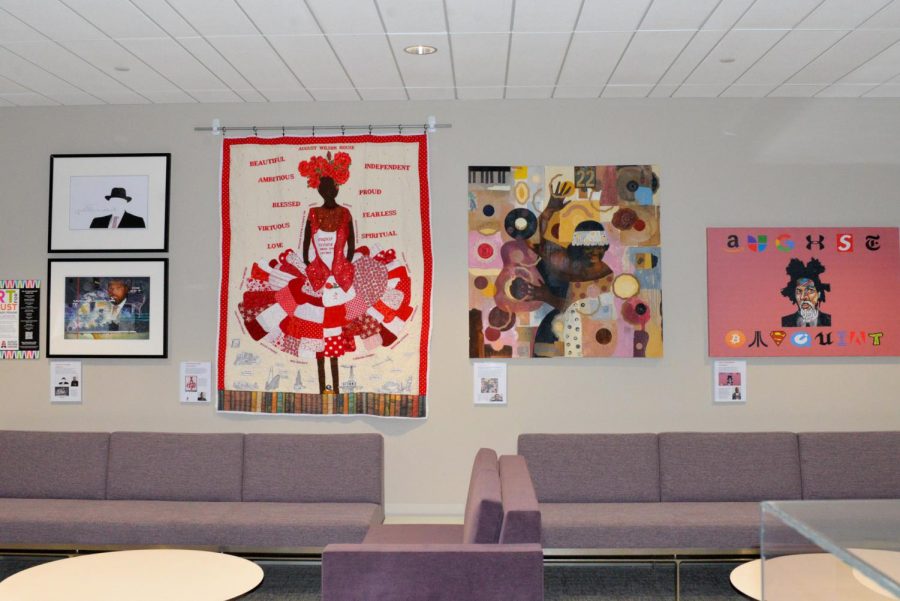‘Art for August’ traveling art exhibit celebrates playwright’s legacy
Aaiush Jain | Staff Photographer
In partnership with the August Wilson House, the University Library System at Pitt’s Hillman Library is the first stop of an exhibit showcasing new and original artwork created by ten local Pittsburgh artists.
November 2, 2021
Pittsburgh playwright August Wilson may have passed away in 2005, but the Hill District native left a strong legacy — which the “Art for August” traveling exhibit is helping keep alive.
Initiated by the August Wilson House, an organization dedicated to celebrating Wilson’s legacy and transforming his childhood home, the art exhibit invites the community to participate in this celebration.
The artwork featured in the exhibit boasts the work of artists from a variety of ages, from young college-aged students to older artists. Their pieces also vary in medium, often in direct relation to the material and images of Wilson’s plays. Visitors could see a physical dress as well as portraits, paintings and drawings.
Wilson wrote plays that have reached audiences far beyond the Pittsburgh area. Some of Wilson’s best known works, such as “Fences” and “The Piano Lesson,” have even been made into films. “Fences” stars A-list performers Denzel Washington and Viola Davis as the lead roles.
The exhibit debuted in April at the Energy Innovation Center, a learning center in Downtown. It then came to Pitt, and will travel through other parts of the City. While at Pitt, the exhibit showcased new and original artwork created by 10 local Pittsburgh artists.
Kornelia Tancheva, the director of Pitt’s University Library System, said the library system is proud to have been the first stop for the “Art for August” exhibit.
“It is one of the events celebrating our acquisition of the August Wilson Archive, which will be officially opened to the public in January 2023,” Tancheva said.
The exhibit was open from Sept. 15 to Oct. 31 to all Pitt students, staff and faculty to visit at any time while the library was open. It has now moved on from Pitt and will be displayed at nearby Carnegie Mellon University from Nov. 1 to Dec. 15.
The August Wilson House, in conjunction with the “Art for August” traveling exhibit, is also restoring Wilson’s childhood home, which is vacant in the Hill District. According to Ed Galloway, the associate University librarian for archives and special collections, the home is marked by a historical marker despite its disheveled appearance.
“The August Wilson House is primarily there to receive the funds to restore the house, and then expand the programming of the house around artists, to attract artists to come and use the house as a place of inspiration and study,” Galloway said.
The restoration process will result in a fully functional house for local artists and creators, rather than serve as a museum about Wilson’s life.
Galloway said the August Wilson Archive, which is a collection of physical materials from Wilson’s life, has been obtained by Pitt Archives & Special Collections. It will serve as the hub for people to see and work with Wilson’s past, and the “Art for August” exhibit acted as a precursor to the opening of the archive and the archive’s goals.
“We really hope that when we open the collection, not just for Pitt students but also with the community of the Hill District, in particular, they’ll be able to continue to do that kind of creative work based on what they’re finding in the collection itself,” Galloway said.
Jeff Wisniewski, a ULS spokesperson, said bringing the artwork to Hillman is really helpful for fostering conversations about Wilson and the broader issues within Black performing arts.
“We are enthusiastic about partnering with local arts organizations to help foster conversations around August and his works,” Wisniewski said. “More specifically, issues of equity, diversity and inclusion.”
Galloway said the artwork in the collection is the product of these local artists’ appreciation for Wilson’s own creative work, specifically his plays. He added that a lot of these artists drew inspiration from his life and legacy as well.
“All these artists have the love of August Wilson, a love of the Hill District and a love of his plays,” Galloway said. “They are inspired in some way by him to spur this creativity.”
One work of art in particular is a painting which features Wilson in the center with images surrounding him. The images showcase different parts of the history and culture for Black people in 20th century Pittsburgh, such as a time when taxis could not drive through the Hill District at all. This is in reference to his series of 10 plays, called “The Pittsburgh Cycle,” which chronicled life for a Black person in Pittsburgh from each decade of the 20th century.
For Wisniewski, the variety of the artwork stood out to him, but he added that the artwork must be seen in person to truly appreciate the different mediums the artists used.
“I’m a fan of the artists’ use of mixed media, which I think you can best appreciate in person,” Wisniewski said.
Tancheva said bringing the exhibit to and featuring it at Pitt connects closely to the library’s focus on preserving and celebrating the lives of Pittsburgh locals.
“It connects closely to our focus on preserving and celebrating the life, work and legacy of August Wilson,” Tancheva said. “It gives us the chance to also celebrate the artistic heritage of local Pittsburgh communities.”



